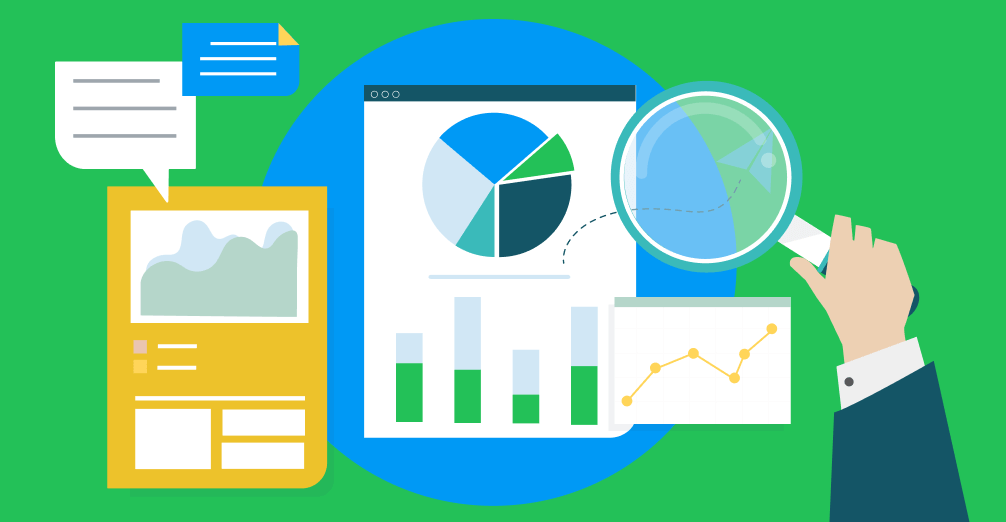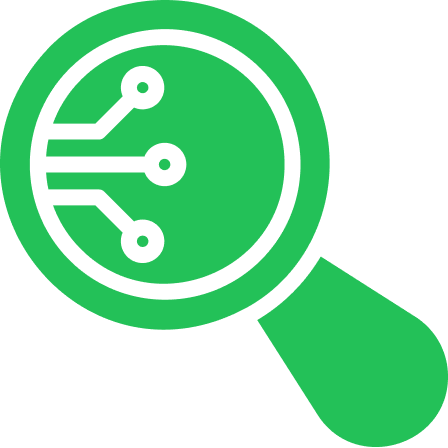Business is all about data – a lot of data. Amidst this data deluge, the ability to extract actionable insights, find security issues, and uncover hidden opportunities has become paramount for driving informed decision-making and gaining a competitive edge. This is where data discovery steps in as a crucial process in modern business operations.
In this article, we'll navigate through data discovery methods, phases, and best practices, shedding light on its transformative power so that you can set your business up for success.
What is data discovery?
Data discovery can be likened to a treasure hunt within your organization's data networks. It involves the exploration and analysis of data to identify patterns, trends, and relationships that may not be immediately apparent.
At its core, data discovery is about empowering organizations to extract maximum value from their data assets by uncovering actionable insights and driving informed decision-making, as well as providing security solutions. Whether it's understanding customer behaviour, optimizing business processes, or identifying market trends, data discovery serves as a powerful tool for extracting actionable intelligence from data.
In the context of security solutions, data discovery plays a crucial role in identifying and mitigating potential risks related to data breaches and unauthorized access. By thoroughly exploring and analysing data, organizations can uncover vulnerabilities and security gaps within their networks.

Data discovery methods and techniques
Data discovery encompasses a variety of methods and techniques aimed at allowing companies to unlock the full potential of their data assets. Here are some commonly employed data discovery methods:
- Data profiling: This method involves analysing the structure, content, and quality of data to gain an understanding of its characteristics. Data profiling helps identify anomalies, inconsistencies, and gaps in data, laying the foundation for further exploration.
- Statistical analysis: Statistical techniques such as regression analysis, clustering, and correlation analysis are used to uncover patterns, trends, and relationships within data. By applying statistical models to large datasets, organizations can extract valuable insights and make data-driven decisions.
- Data visualization: Data visualization techniques, such as charts, graphs, and dashboards, are employed to visually represent data in a way that is easy to understand and interpret. Visualization aids in uncovering patterns, trends, and anomalies that may not be immediately apparent from raw data.
- Machine learning and AI: Machine learning and artificial intelligence (AI) algorithms are increasingly being utilized for data discovery tasks. These algorithms can quickly analyse large volumes of data, identify patterns, and make predictions or recommendations based on past data.
- Natural language processing (NLP): NLP techniques enable computers to understand, interpret, and generate human language. In the context of data discovery, NLP can be used to analyse unstructured data such as text documents, emails, and social media posts, extracting insights and sentiment from textual data sources.
Here's a closer look at some key techniques and approaches used for data discovery:
Automated discovery
Automated data discovery leverages software tools and algorithms to analyse large volumes of data quickly and efficiently. These tools can automatically scan, classify, and analyse data sources to identify patterns, trends, and anomalies.
Automated discovery plays a crucial role in enhancing data security by identifying potential vulnerabilities and ensuring compliance with data protection regulations. Robust data loss protection solutions offer automated capabilities, enabling organizations to efficiently scan their data and uncover not only risky behaviour by employees and potential data leaks, but also ensure compliance with various data regulations.
Tip: By purchasing the Safetica Compliance license, organizations can simply import various regulatory compliance templates into the Safetica Management Console of their Safetica. Organizations can then set up data discovery tasks, easily identify and monitor sensitive data to ensure security and compliance with data security regulations.
Manual discovery
Manual data discovery involves human-led exploration and analysis of data sources to uncover insights and trends manually. While automated tools can handle large-scale data analysis tasks, there are instances where human intuition and expertise are invaluable. Manual discovery allows data analysts to dive deep into specific datasets, ask nuanced questions, and uncover insights that automated tools may overlook (yes, it happens both ways!).
Pattern recognition
Pattern recognition techniques involve identifying recurring patterns, trends, or anomalies within datasets. These methods leverage statistical analysis, machine learning algorithms, and pattern recognition models to detect meaningful patterns in data. By identifying patterns, organizations can gain insights into customer behaviour, market trends, and operational inefficiencies, enabling them to optimize processes and fuel business growth.
Predictive analytics
Predictive analytics goes beyond uncovering historical trends to forecast future. By analysing historical data and identifying patterns, predictive analytics models can make informed predictions and recommendations about future events or trends. Organizations can use this data discovery method to anticipate customer needs, mitigate risks, and capitalize on emerging opportunities.
By employing a blend of automated discovery, manual analysis, pattern recognition, and predictive analytics techniques, organizations can maximize the effectiveness of their data discovery efforts.

The phases of data discovery
The process of data discovery unfolds in several phases, each contributing to the comprehensive understanding and utilization of data assets. Let’s look at a step-by-step breakdown of the phases involved in data discovery, illustrated with practical examples. However, depending on the specific context and requirements of a data discovery project, organizations may choose to adapt or expand upon these phases based on their unique requirements and objectives.
- Goals & scope: Before even starting data exploration, organizations must outline clear objectives and define the scope of their analysis.
For example, a marketing team may set a goal to understand customer preferences based on historical purchase data, focusing on a specific product line or demographic segment.
- Data collection: With goals established, the next step is to gather relevant data from various sources. This may involve extracting data from databases, data warehouses, spreadsheets, or external sources such as APIs and web scraping. Data collection is a critical phase that ensures the availability of high-quality data for analysis.
For instance, an e-commerce company might collect customer transaction data from its website, mobile app, and third-party platforms to gain insights into buying patterns and user behaviour.
- Data cleaning: Raw data is often riddled with inconsistencies and errors that need to be addressed. In this phase, data is cleaned to ensure accuracy.
For example, duplicate records are removed, missing values are imputed, and data formats are standardized for uniform analysis.
- Data preprocessing: Once the data is cleaned, it undergoes preprocessing to prepare it for analysis.
For instance, numerical data may be normalized, categorical data may be encoded, and text data may be tokenized. Preprocessing ensures that the data is in a suitable format for further exploration and analysis.
- Data profiling: Data profiling involves examining the characteristics and quality of the collected data. Data profiling techniques help identify outliers, anomalies, and data quality issues that may affect the accuracy and reliability of subsequent analyses.
For example, a healthcare provider might profile patient medical records to identify trends in diagnoses or treatment outcomes, uncovering potential areas for improvement in patient care.
- Data analysis: In this phase, the cleaned and profiled data undergoes rigorous analysis using various statistical, machine learning, and data mining techniques.
For example, in the healthcare industry, data analysis may involve examining patient records, medical histories, and treatment outcomes to identify patterns and trends. By applying advanced analytics methods such as predictive modelling and risk stratification, healthcare organizations can predict patient outcomes, identify high-risk individuals, and personalize treatment plans. Data analysis in healthcare enables healthcare providers to optimize care delivery, improve patient outcomes, and reduce healthcare costs.
- Data visualization: Visual representations such as charts and graphs are used to communicate insights in a clear and intuitive manner.
For instance, a logistics company might use heatmaps to visualize delivery routes and identify areas with high traffic congestion, optimizing route planning and resource allocation.
- Actionable insights, interpretation: In this phase, the results of data analysis are interpreted to derive actionable next steps, optimize processes, and drive business outcomes. Interpretation involves understanding the implications of the findings and identifying opportunities for improvement or intervention.
For example, a financial institution may analyse customer transaction data to detect fraudulent activities, enabling prompt intervention to safeguard customer assets.
- Reporting & communication: Findings are documented and shared with stakeholders through reports and presentations.
For instance, a manufacturing company might compile a dashboard displaying real-time production metrics to facilitate decision-making and performance tracking.
- Iteration & refinement: Data discovery is an iterative process, with insights leading to further exploration and refinement. Feedback from stakeholders, new data sources, and evolving business needs may require revisiting earlier phases of the data discovery process.
For example, an educational institution may analyse student performance data to identify areas for curriculum enhancement, refining teaching methods to improve learning outcomes.
Data discovery best practices
To maximize the effectiveness of data discovery initiatives, organizations should follow these best practices:
Data governance
Establish clear data governance policies and procedures to ensure data accuracy, consistency, and compliance with regulatory requirements. Implement data stewardship roles and responsibilities to oversee data quality and integrity.
Data security
Prioritize data security by implementing robust security measures such as encryption, access controls, and user authentication. Use a solid DLP software to monitor usage to detect and prevent unauthorized and malicious activities not only by 3rd parties, but also by insiders, and regularly audit data security policies and procedures.
Data privacy considerations
Respect data privacy regulations and standards such as GDPR, HIPAA, and CCPA by implementing appropriate privacy controls and safeguards. Obtain explicit consent from individuals before collecting or processing their personal data and provide transparency regarding data handling practices. Keep up to date with the newest data security regulations.
The challenges associated with data discovery
Embarking on a data discovery journey comes with its fair share of challenges. From navigating complex data landscapes to ensuring data integrity and scalability, businesses encounter several obstacles along the way. Here's a closer look at some common challenges and strategies for overcoming them:
Problem 1: Data silos
Data silos refer to isolated pockets of data stored across different systems or departments within an organization. These silos often arise when information is hoarded or segregated, hindering collaboration and data sharing across the organization. As a result, accessing and analyzing data becomes difficult, leading to inefficiencies and missed opportunities for insights. To overcome data silos, organizations need to integrate their data sources and establish a unified data architecture that promotes seamless data access and collaboration across departments.
Problem 2: Data quality issues
Poor data quality, marked by inaccuracies, inconsistencies, and outdated information, poses a significant challenge to data discovery initiatives. That’s why it’s crucial not to give in to the temptation to skip the data cleaning process, make sure to establish comprehensive data governance practices, and utilize advanced data quality tools. These measures ensure that the data used for analysis is accurate, reliable, and up-to-date.
Problem 3: Scalability concerns
As the volume of data continues to grow exponentially, scalability emerges as a critical concern for data discovery efforts. Organizations must invest in scalable infrastructure and technologies capable of accommodating large and diverse datasets, ensuring that data discovery initiatives can scale seamlessly as data volumes increase.
DLP solutions can play a crucial role in managing and securing this data effectively as the organization grows. By implementing scalable DLP solutions, organizations can ensure that their data protection measures can adapt to the evolving needs of the business without compromising security or performance. (Pst! Safetica’s DLP solutions can be customized and will adapt to your company’s needs!)

Empowering data discovery with Safetica's solutions
Safetica's DLP software and data discovery solutions stand at the forefront of modern data protection and insights extraction. With intuitive interfaces and advanced visualization tools, Safetica empowers users to navigate through vast data landscapes with ease and precision.
Safetica's Data Loss Prevention (DLP) solutions are engineered to tackle the most pressing challenges in data management. From addressing data silos to resolving data quality issues and scalability concerns, Safetica offers a centralized platform for overseeing sensitive data across the organization: one for enterprises and one for SMBs.
Through its innovative solutions, Safetica enables businesses to seamlessly implement robust data discovery strategies while adhering to stringent regulations and industry standards. With Safetica's comprehensive DLP capabilities, organizations can elevate their data visibility, safeguard sensitive information, and navigate the complexities of the digital landscape with confidence.






